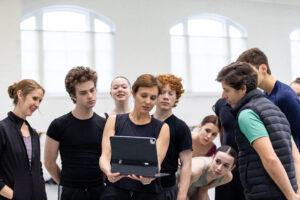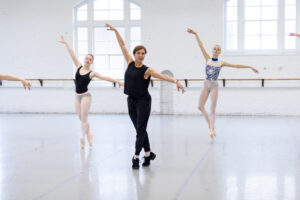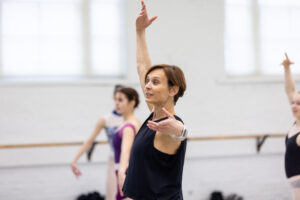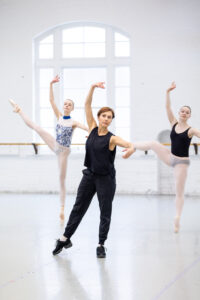



June 1-3, 2023, our Academy Trainees will have the amazing opportunity of performing George Balanchine’s Walpurgisnacht. Rebecca Metzger, a highly accomplished performer, director, and repetiteur from the Balanchine Trust, spent a week in January instructing the dancers in the nuances of the work. To perform a Balanchine work is to prove your technical aptitude and to add an impressive legacy to your resume. Walpurgisnacht is sure to be the highlight of their showcase performance this June!
But some may ask:
Who is “George Balanchine”?
For those of you who are a bit lost, here’s what you need to know about the father of American ballet.
THE ABSOLUTE BASICS
George Balanchine was born in Russia in 1904, studied ballet and piano, traveled around Europe in the 1920s teaching and choreographing, then moved to America to start a school and a company. His work established the recognizable aesthetic and home institution of American ballet, contributing to worldwide recognition of American dance.
A LITTLE MORE DETAIL
George Balanchine was born in St. Petersburg in 1904. In his early childhood, his father taught him piano. He trained at the Imperial Ballet School and then danced with the State Academic Theater of Opera and Ballet (today known as the Vaganova Ballet Academy and the Mariinsky Ballet respectively). With a few friends, he organized “Evenings of the Young Ballet”, where he first began to choreograph. The group went on a tour of Europe in 1924 and defected from Russia. They joined Sergei Diaghilev’s Ballet Russes, where George continued to choreograph (key works: Apollo, Prodigal Son). After Diaghilev’s death, George traveled around Europe until he met Lincoln Kirstein in 1933 and moved to America. There, George began a ballet school with Lincoln Kirstein and Edward M. M. Warburg’s support (key work: Serenade). He started a few ballet companies, choreographed for Hollywood and Broadway (key works: On Your Toes, The Goldwyn Follies, Cabin in the Sky), took a few years back in Europe (key works: Raymonda, La Sonnambula, Le Palais de Cristal/Symphony in C), and then in 1948 returned to start the New York City Ballet, where he remained until his death in 1983 (key works: The Four Temperaments, Jewels, Stars and Stripes, Agon, Firebird, Nutcracker). His style combined classical ballet technique with Africanist influences and his own deep musicality, resulting in a distinctive aesthetic known as neoclassical ballet. He was married four times, choreographed over 400 works, and has a crater on Mercury named after him. Today, the New York City Ballet and its accompanying School of American Ballet are the largest ballet institutions in America. His repertory of works is managed by the Balanchine Trust.
THE LARGER STORY
Russia
George Balanchine was born Georgi Melitonovich Balanchivadze in St. Petersburg, Russia in 1904. His childhood was spent studying music with his father, a composer. As his family was deeply religious, he was raised Orthodox Christian and carried that faith with him throughout his life. Georgi hoped to attend the Imperial Navy Academy. However, when his mother Maria brought his sister Tamara to the Imperial Ballet School to audition, she brought Georgi along. Since they were there, the instructors encouraged Maria to have her son audition as well. He was accepted—and promptly ran away.
His aunt found him and took him back to the school, where he would train from 1913 through World War I until the Russian Revolution brought new regimes to power in 1917. At that point the ballet school was closed by the government. Georgi took to playing piano at movie houses in return for scraps of food among other odd jobs. In 1918, after much work from Anatole Lunacharsky, the school reopened as the Leningrad Choreographic School and Georgi finished his training. He presented his first work, a pas de deux done for a student concert, in 1920.
During his time as a student, he was remembered for his habit of ducking into unoccupied studios to play the piano. Georgi chose to enroll in the Petrograd Conservatory of Music in 1919 to continue his study of music while performing with the State Academic Theater of Opera and Ballet. He married Tamara Geva, another ballet student, in 1921. Interested in choreographing further, Georgi formed a group with fellow students titled “Evenings with the Young Ballet”. Reactions to the Young Ballet’s repertoire were mixed. This dance group eventually got permission to leave Russia and tour as the Soviet State Dancers, thanks to the efforts of opera singer Vladimir Dimitriev.
Europe
This 1924 tour was not well received by European theaters. Funds ran out quickly, and so hotels were rundown and meals nonexistent at times. Even so, when the time came to return home, the dancers—Georgi Balanchivadze, Tamara Geva, Alexandra Danilova and Nicholas Efimov—looked at each other and decided to miss the boat.
The freshly-defected artists did their best to find work until meeting Sergei Diaghilev, an impresario known for bringing together multiple art forms to create lavish productions. Diaghilev accepted them into his company, Ballets Russes. He noticed Georgi’s knack for choreography and asked him to create something for Ballets Russes. Apollon Musagète (now known as simply Apollo) and Prodigal Son were the results. Igor Stravinsky composed the music for Apollo, and Sergei Prokofiev for Prodigal Son. Apollo was the beginning of an artistic collaboration with Stravinsky that would underscore much of Georgi’s later career. As he continued to choreograph for Ballets Russes, Diaghilev encouraged Georgi to change his name to something more marketable—something like, say, George Balanchine. Although George was given many opportunities with Ballets Russes, his wife Tamara was not. In 1926 she chose to leave the company and separate from him in order to pursue other artistic options.
George Balanchine created works for Ballets Russes up until Diaghilev’s death in 1929. He then spent several years floating around Europe, moving between various companies as a ballet master and choreographer. Another dancer who had followed him from Russia, Alexandra Danilova, formed an intimate partnership with Balanchine during this period, although they never married. In 1933 Balanchine founded his own company: Les Ballets. That same year he met Lincoln Kirstein, an American with a deep love for the arts and even deeper pockets. Kirstein convinced him to come to America and establish a home for American ballet. At that point in time, ballet had no strong foundation in America. Few American ballerinas were known worldwide, and they had only gained acclaim after dancing for a European company, as in the case of Augusta Maywood at the Paris Opera in the 1800s. Kirstein wanted this to change and had finally found the man to make it happen.
America
On October 18 of 1933, George Balanchine stepped onto American soil. Legend has it that Balanchine responded to Kirstein’s initial request for a company with the famous words, “But first, a school.” In order to solidify American ballet, there had to be a place for American dancers to train in the required techniques. This school was initially established in Hartford, Connecticut, funded by Edward M. M. Warburg and Lincoln Kirstein. It was here that Balanchine choreographed his much-lauded work Serenade. A performing group was formed for the first public performance: the American Ballet. In 1934, the school moved to New York and reasserted itself as the School of American Ballet.
After an unsuccessful touring attempt where the American Ballet’s funding ran out halfway through Pennsylvania, hope was found in an invitation from the Metropolitan Opera. Balanchine was invited to become the ballet master and the American Ballet the resident ballet company. Due to severe artistic differences, this arrangement was short-lived and ended bitterly for everyone involved. The American Ballet departed the Met and dissolved.
While in residence at the Met, Balanchine had begun to choreograph for Broadway productions. Upon leaving, he moved to Hollywood and continued to choreograph movies and musicals. The Goldwyn Follies, a massive undertaking directed by Samuel Goldwyn, starred Vera Zorina, who Balanchine would soon marry. He also collaborated with Katherine Dunham, a pioneer of modern dance, on the musical Cabin in the Sky. Balanchine was open to learning from other styles of dance; theatrical dance drew heavily on Africanist aesthetics and forms. The elements of these aesthetics inspired Balanchine’s own take on ballet, featuring polycentrism and polyrhythms. The new “American” ballet drew from “American” dance, with the all-American cultural influence of slavery and Africanist dance present in the movement.
In 1941, Balanchine left commercial dance and tried his hand at an artistic company again. The American Ballet Caravan spent five months touring South America. Once again, the company disbanded at the end of the tour. Balanchine then moved back overseas to choreograph for Ballet Russe de Monte Carlo in 1944. There, he met Maria Tallchief, whom he would marry in 1946 and separate from in 1951.
Lincoln Kirstein re-emerged in 1946 with a new inheritance at his disposal. Kirstein had been maintaining the school while Balanchine traveled back and forth from Europe. The inheritance made forming another company possible. This time, both Kirstein and Balanchine were more intentional. Artistic integrity was prized above all else. Accordingly, Ballet Society was initially subscription-only, allowing Balanchine to take more risks and ignore box office wisdom. The Four Temperaments was presented in America that year, featuring a commissioned score from Paul Hindemith and (initially) costumes designed by Kurt Seligmann. A pre-performance decision by Balanchine to take a pair of scissors to the elaborate costumes marked a change in Balanchine’s style: practice leotards and tights for costumes, bare sets, and a clear Africanist influence from his Broadway years, found in the weight shifts and syncopations.
Kirstein’s latest inheritance ran out quickly, even with the sparse sets and costumes Balanchine now favored. Morton Baum, the chairman of the New York City Center of Music and Drama finance committee, came to the rescue. After having seen one of Balanchine’s works by happenstance, he was absolutely entranced. He persuaded the City Center to provide a home and funding to Ballet Society. In 1948, Ballet Society was renamed to the New York City Ballet.
George Balanchine continued as NYCB’s director. Jerome Robbins, another Broadway and ballet choreographer, was soon hired as the Assistant Artistic Director. In 1952, Balanchine married NYCB ballerina Tanaquil Le Clercq. She was a renowned performer, originating iconic roles like The Nutcracker’s Dewdrop, until polio paralyzed her from the waist down in 1956. The company continued without her. A 1963 grant from the Ford Foundation of 7.7 million dollars (~75 million in today’s currency) solidified NYCB’s financial standing and status as an American institution. For the next twenty years, Balanchine taught, directed, and choreographed, building an impressive repertoire ranging from story ballets to lighthearted romps to plotless neoclassical wonders. In 1975, Walpurgisnacht premiered at the Paris Opera and later in 1980 was performed by the New York City Ballet—the very piece that our Trainees are currently learning. Just three years later, George Balanchine passed away from pneumonia. He was 79 years old.
Legacy
Even forty years after his death George Balanchine’s name echoes across the ballet world. Despite his many controversies (which this article has not discussed), his choreographic skill and strength of vision have had an undeniable influence on the field. His plotless ballets, integral sense of musicality, and avant-garde aesthetic choices established America as a true center of ballet in the 20th century. Neoclassical ballet still permeates American choreography thanks to his students, who went on to have careers as strong directors, renowned choreographers, and accomplished performers. BalletMet’s own Artistic Director—Edwaard Liang—danced with NYCB earlier in his career. Today the New York City Ballet runs on a budget of almost 100 million dollars, the largest of any American ballet institution, and employs ninety dancers. Balanchine’s 400 works are licensed by the Balanchine Trust, an organization that keeps meticulous archives of his repertoire and travels from company to company restaging ballets. The boy who ran away from ballet school; the European ballet master; the choreographer responsible for American ballet: George Balanchine.
STILL CURIOUS?
Brenda Dixon Gottschild: NYT Letter to the Editor; Digging the Africanist Presence in American Performance: Dance and Other Contexts, “Stripping the Emperor: The Africanist Presence in American Concert Dance” (book chapter)
Ann Daly: The Balanchine Woman: Of Hummingbirds and Channel Swimmers (article)
Camille Hardy: Bringing Bourrées to Broadway: George Balanchine’s Career in the Commercial Theater (article)
Jennifer Homans: Interview with The Nation
Bernard Taper: Balanchine: A Biography (book)
The Balanchine Trust: Timeline
The Collector: Balanchine and His Ballerinas (article)
The New York Times: Obituary
The Mariinsky Theatre: Brief History
Vaganova Ballet Academy: Brief History
BALANCHINE is a Trademark of The George Balanchine Trust.
Written by Sara Wagenmaker

